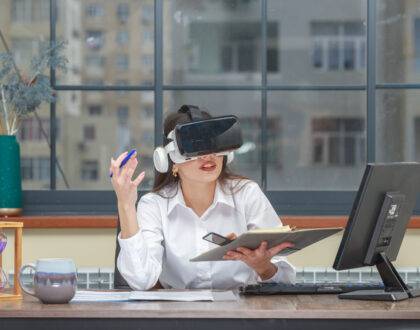Wearable Tech and Health Monitoring: Beyond Fitness Trackers

by Web Digital
In the fast-paced world of technological innovation, wearables have become more than just fashion statements. They’ve evolved into essential tools for tracking and enhancing our health. While fitness trackers paved the way, the latest generation of wearable tech goes beyond mere step counting. These devices offer an array of health monitoring capabilities, transforming the way we manage our well-being. This article delves into the world of wearable tech, exploring the exciting advancements and the potential impact on healthcare beyond fitness tracking.
1. The Fitness Tracker Revolution: A Starting Point
The wearable tech revolution began with fitness trackers, such as Fitbit and Garmin. These early devices primarily focused on counting steps, monitoring heart rates, and estimating calorie expenditure. While these features were groundbreaking at the time, they represent only a fraction of the capabilities now available in modern wearables.
2. Smartwatches: The Convergence of Style and Health
Smartwatches have emerged as the epitome of wearable technology, combining the functionality of fitness trackers with the features of traditional timepieces. Beyond tracking physical activity, smartwatches offer features like GPS navigation, message notifications, and voice assistants. But their real power lies in their health-monitoring capabilities.
3. Heart Rate Monitoring: A Window into Health
Most smartwatches now include continuous heart rate monitoring. This feature not only provides valuable data for tracking fitness but can also alert wearers to irregular heart rhythms. In some cases, these alerts have been lifesaving, as they can indicate potentially serious conditions like atrial fibrillation.
4. Sleep Tracking: A Key to Better Rest
Understanding sleep patterns is critical for overall health. Many wearables now include sleep-tracking features, providing insights into the duration and quality of sleep. This information can help individuals make lifestyle adjustments to improve their sleep and overall well-being.
5. Blood Pressure Monitoring: A Game Changer
Recent advancements have brought blood pressure monitoring to wearable devices. By integrating sensors and algorithms, wearables can now estimate blood pressure non-invasively. This development has the potential to revolutionize hypertension management, allowing individuals to track their blood pressure trends more conveniently and regularly.
6. Blood Oxygen Monitoring: Vital Insights
Blood oxygen saturation, or SpO2, is a crucial metric for assessing respiratory health. Wearables with SpO2 sensors can help individuals monitor their blood oxygen levels, which is particularly relevant in the context of conditions like sleep apnea and COVID-19.
7. ECG and Afib Detection: Early Warning Systems
Electrocardiogram (ECG) capabilities in wearables have opened new doors in heart health monitoring. Devices like the Apple Watch can record ECGs, potentially detecting atrial fibrillation (Afib) and other arrhythmias early. This not only empowers individuals to take proactive steps but also facilitates remote monitoring by healthcare professionals.
8. Temperature Sensing: Early Signs of Illness
Some wearables are equipped with temperature sensors, allowing wearers to track their body temperature continuously. This can serve as an early indicator of illness, including fever, which can be especially valuable in the context of infectious diseases.
9. Mental Health Tracking: A Growing Focus
Mental health is as vital as physical health, and some wearables are expanding their capabilities to track emotional well-being. These devices can monitor stress levels, provide guided breathing exercises, and offer insights into overall mental wellness.
10. Fall Detection: Safety for Seniors
For older adults, wearables with fall detection features can be a lifesaver. These devices use motion sensors and algorithms to detect falls and automatically alert emergency contacts if necessary, ensuring prompt assistance in case of accidents.
11. Medication Reminders and Health Apps: Enhancing Adherence**
Wearables often integrate with health apps that provide medication reminders and track adherence. These tools are especially beneficial for individuals with chronic conditions who require strict medication schedules.
12. Data Sharing and Healthcare Integration: The Future of Telemedicine
The data collected by wearables is not just for personal use. With user consent, this information can be shared with healthcare providers, facilitating remote monitoring and more informed medical decisions. This integration is a crucial component of the future of telemedicine and virtual healthcare.
13. Challenges and Considerations
While wearable tech holds immense promise for health monitoring, several challenges must be addressed:
a. Data Privacy and Security: The collection and storage of personal health data raise significant privacy and security concerns. Manufacturers and healthcare providers must prioritize robust data protection measures.
b. Accuracy and Reliability: Ensuring the accuracy and reliability of health data generated by wearables is paramount. Users and healthcare professionals need to have confidence in the data for informed decision-making.
c. Accessibility and Equity: The adoption of wearable tech should be accessible to all, regardless of socioeconomic status or technological literacy. Ensuring equity in access to these devices is crucial.
d. Regulatory Oversight: As wearables play an increasingly prominent role in healthcare, regulatory bodies must adapt to ensure the safety and effectiveness of these devices.
e. User Education: Proper training and education are essential to help individuals understand and interpret the health data provided by wearables.
Conclusion: The Future of Personalized Healthcare
Wearable tech has evolved from simple fitness trackers to sophisticated health monitoring devices that empower individuals to take charge of their well-being. These devices offer a personalized and continuous stream of health information that can lead to earlier detection of health issues and better management of chronic conditions.
As technology continues to advance, wearable tech’s role in healthcare is likely to expand further, with the potential to transform how we access and receive medical care. The future holds exciting possibilities for the integration of wearable tech into telemedicine, preventive care, and remote patient monitoring, ultimately leading to more proactive and personalized healthcare solutions. Wearable tech is not just a trend; it’s a transformative force shaping the future of healthcare.
Recommended Posts

Exploring the Transformative Influence of Technology in Sports
December 5, 2023

Tech Innovations in Renewable Energy Storage
December 4, 2023

Tech in Entertainment: VR Experiences and Immersive Content
December 2, 2023
